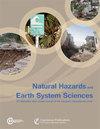2018年欧洲中西部的干旱预计气候会变暖:它会变得多干燥?
IF 4.7
2区 地球科学
Q1 GEOSCIENCES, MULTIDISCIPLINARY
引用次数: 7
摘要
摘要在未来气候条件下对极端干旱变化的预估具有很大的不确定性,这是由于干旱的复杂成因和大气动力学模式的很大不确定性。在这项研究中,我们通过伪全球变暖(PGW)实验研究了全球变暖对西欧中部土壤湿度干旱严重程度的影响,该实验预测了1980-2020年全球变暖的世界。未来与当前干旱事件类似的情景,使研究干旱严重程度的变化成为可能,而干旱严重程度的变化取决于大气环流的历史逐日演变。2018年西欧中部干旱是该地区1980 - 2020年参考期内最严重的干旱。在1.5°C、2°C和3°C的全球变暖下,与气候变化相比,这一干旱期的夏季气温明显升高,但土壤湿度的干燥反应相对温和。这主要是因为在当前条件下,蒸发已经受到强烈的水分限制,限制了蒸发的增加,从而限制了PGW下温度响应的调节。冬季、春季和秋季降水的增加限制或阻止了干旱的早期发生和持续时间。然而,以累积土壤水分亏缺量来定义的干旱严重程度,在2°C变暖的情况下,增加了20%到39%。1980-2020年间极端干旱的频率在2°C的变暖下急剧增加。在今天的条件下,若干年没有明显的干旱,则显示出非常强烈的干燥和变暖。这导致2003年那样的干旱事件增加,加上当地夏季气温明显升高超过2°C。即使不考虑对气候变化的(潜在的)动态响应,在全球变暖的情况下,西欧中部的干旱风险也大大增加。由于干旱频率、严重程度和复合热量的增加,预计两次干旱之间的恢复时间将缩短。我们的物理气候故事线为传统的大集合方法提供了补充证据,旨在为制定有效的适应策略做出贡献。本文章由计算机程序翻译,如有差异,请以英文原文为准。
The 2018 west-central European drought projected in a warmer climate: how much drier can it get?
Abstract. Projections of changes in extreme droughts under future
climate conditions are associated with large uncertainties, owing to the
complex genesis of droughts and large model uncertainty in the atmospheric
dynamics. In this study we investigate the impact of global warming on soil
moisture drought severity in west-central Europe by employing pseudo global
warming (PGW) experiments, which project the 1980–2020 period in a globally
warmer world. The future analogues of present-day drought episodes allow for
investigation of changes in drought severity conditional on the historic
day-to-day evolution of the atmospheric circulation. The 2018 west-central European drought is the most severe drought in the
1980–2020 reference period in this region. Under 1.5,
2 and 3 ∘C global warming, this drought episode
experiences strongly enhanced summer temperatures but a fairly modest soil
moisture drying response compared to the change in climatology. This is
primarily because evaporation is already strongly moisture-constrained
during present-day conditions, limiting the increase in evaporation and thus
the modulation of the temperature response under PGW. Increasing
precipitation in winter, spring and autumn limits or prevents an earlier
drought onset and duration. Nevertheless, the drought severity, defined as
the cumulative soil moisture deficit volume, increases considerably, with
20 % to 39 % under 2 ∘C warming. The extreme drought frequency in the 1980–2020 period strongly increases
under 2 ∘C warming. Several years without noticeable droughts
under present-day conditions show very strong drying and warming. This
results in an increase in 2003-like drought occurrences, compounding with
local summer temperature increases considerably above 2 ∘C. Even without taking into account a (potentially large) dynamical response to
climate change, drought risk in west-central Europe is strongly enhanced
under global warming. Owing to increases in drought frequency, severity and
compounding heat, a reduction in recovery times between drought episodes is
expected to occur. Our physical climate storyline provides evidence
complementing conventional large-ensemble approaches and is intended to
contribute to the formulation of effective adaptation strategies.
求助全文
通过发布文献求助,成功后即可免费获取论文全文。
去求助
来源期刊
CiteScore
7.60
自引率
6.50%
发文量
192
审稿时长
3.8 months
期刊介绍:
Natural Hazards and Earth System Sciences (NHESS) is an interdisciplinary and international journal dedicated to the public discussion and open-access publication of high-quality studies and original research on natural hazards and their consequences. Embracing a holistic Earth system science approach, NHESS serves a wide and diverse community of research scientists, practitioners, and decision makers concerned with detection of natural hazards, monitoring and modelling, vulnerability and risk assessment, and the design and implementation of mitigation and adaptation strategies, including economical, societal, and educational aspects.

 求助内容:
求助内容: 应助结果提醒方式:
应助结果提醒方式:


